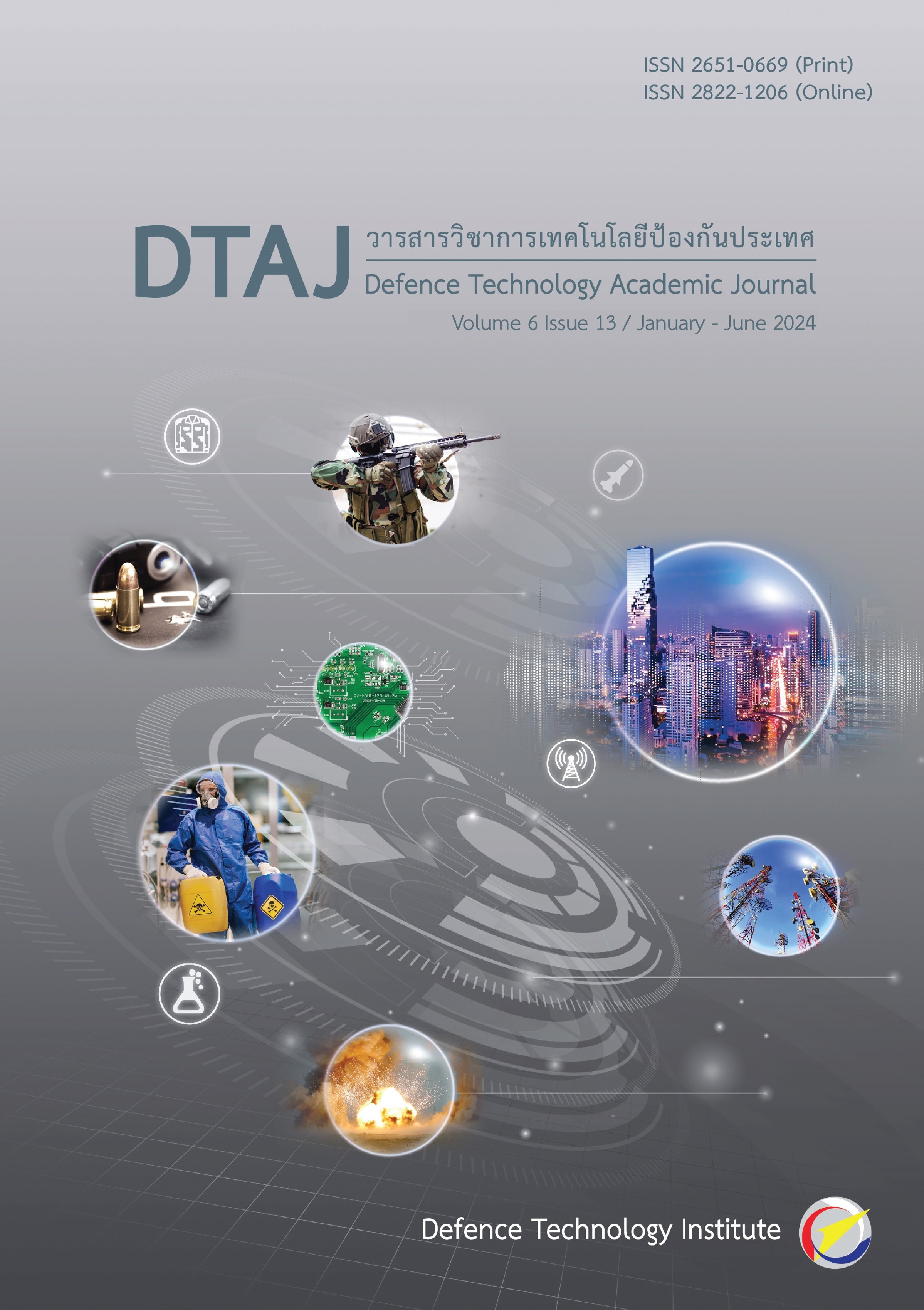การจำแนกประเภทอาวุธโดยใช้โครงข่ายประสาทเทียมแบบคอนโวลูชันที่มีการปรับรูปแบบให้เหมาะสมสำหรับอุปกรณ์พกพา
Main Article Content
บทคัดย่อ
บทความนี้มีวัตถุประสงค์เพื่อศึกษาขั้นตอนการพัฒนากระบวนการสำหรับการจำแนกอาวุธจากข้อมูลภาพ จำนวน 8 ชนิด โดยการประยุกต์ใช้โมเดลการเรียนรู้เชิงลึก ด้วยการนำเทคโนโลยีคอมพิวเตอร์วิชันมาใช้ในการรับรู้ภาพแบบอัตโนมัติและจำแนกภาพอาวุธ เพื่อแก้ปัญหาความผิดพลาดในการวิเคราะห์ข้อมูลภาพที่มีจำนวนมากด้วยสายตามนุษย์ได้อย่างถูกต้องและมีประสิทธิภาพ การลดขนาดของข้อมูลให้สามารถใช้งานบนอุปกรณ์พกพาขนาดเล็ก พร้อมทั้งได้พัฒนาโมเดลในการจำแนกย่อยเฉพาะในคลาสเครื่องบินที่สามารถติดยุทโธปกรณ์ทางการรบและเครื่องบินทั่วไป ซึ่งมีความยากและซับซ้อนในการจำแนกเนื่องจากมีลักษณะทางกายรูปที่ใกล้เคียงกัน เช่น สี ขนาด และ รูปร่าง ดังนั้นการศึกษานี้จึงใช้ TensorFlow และ Keras ซึ่งเป็นไลบรารีสำหรับพัฒนาการเรียนรู้ของเครื่องด้วยอัลกอริทึมโครงข่ายประสาทเทียมแบบคอนโวลูชัน อีกทั้งยังเพิ่มประสิทธิภาพของโมเดลการเรียนรู้เชิงลึก พร้อมทั้งเปรียบเทียบโมเดลพร้อมใช้งานที่ได้รับการฝึกฝนมาก่อน 8 แบบ ผลลัพธ์ที่ได้จากการศึกษานี้แสดงให้เห็นว่าโมเดล EfficientNet-B0 มีค่าความถูกต้องในการจำแนกอาวุธจากข้อมูลภาพ เท่ากับ 94.01% นอกจากนั้นยังใช้คุณสมบัติของไลบรารี TensorFlow Lite แปลงค่าพารามิเตอร์ นำโมเดลเข้าสู่กระบวนการคำนวณระบบเลขจำนวนเต็มด้วยหลักการทำ Quantization ในการลดขนาดของข้อมูลเพื่อปรับใช้งานและการเพิ่มประสิทธิภาพของระบบการเรียนรู้ของเครื่อง รวมถึงแสดงการเปรียบเทียบคุณสมบัติ ขนาดข้อมูล เวลาแฝง และความแม่นยำ ให้เหมาะสมกับอุปกรณ์สามารถนำไปใช้บนอุปกรณ์พกพาได้ ซึ่งผลการทดลองของโมเดลแบบ int8 มีขนาดเล็กที่สุดได้ค่าความแม่นยำ 88.64%
Downloads
Article Details

This work is licensed under a Creative Commons Attribution-NonCommercial-NoDerivatives 4.0 International License.
Journal of TCI is licensed under a Creative Commons Attribution-NonCommercial-NoDerivatives 4.0 International (CC BY-NC-ND 4.0) licence, unless otherwise stated. Please read our Policies page for more information...
References
P. Cheewaprakobkit, “Improving the Performance of an Image Classification with Convolutional Neural Network Model by Using Image Augmentations Technique,” TNI J. Eng. Technol., vol. 7, no. 1, pp. 59 - 64, Jan. - Jun. 2019.
K. Chauhan and S. Ram, “Image Classification with Deep Learning and Comparison between Different Convolutional Neural Network Structures Using Tensorflow and Keras,” Int. J. Adv. Eng. Res. Dev. (IJAERD). vol. 5, no. 2, pp. 533 - 538, 2018.
Google LLC Kaggle. (2024). Datasets Explore. [Online]. Available: https://www.kaggle.com/datasets
J. Kukačka, V. Golkov, and D. Cremers, “Regularization for Deep Learning: A Taxonomy,” ArXiv, pp. 1 – 23, 2017, doi: 10.48550/arXiv.1710.10686.
S. Ioffe and C. Szegedy, “Batch Normalization: Accelerating Deep Network Training by Reducing Internal Covariate Shift,” ArXiv, pp. 1 - 11, 2015, doi: 10.48550/arXiv.1502.03167.
A. Budhiman, S. Suyanto, and A. Arifianto, “Melanoma Cancer Classification Using ResNet with Data Augmentation,” 2019 International Seminar on Research of Information Technology and Intelligent Systems (ISRITI), Yogyakarta, Indonesia, 2019, pp. 17 - 20, doi: 10.1109/ISRITI48646.2019.9034624.
N. Srivastava, G. Hinton, A. Krizhevsky, I. Sutskever, and R. Salakhutdinov, “Dropout: A Simple Way to Prevent Neural Networks from Overfitting,” J. Mach. Learn. Res., vol. 15, no. 56, pp. 1929 - 1958, 2014.
Tensorflow for Mobile & Edge (2024). Datasets Explore. [Online]. Available: https://www. tensorflow.org/lite/examples/image_classification/overview
สถาบันเทคโนโลยีป้องกันประเทศ (องค์การมหาชน) กระทรวงกลาโหม. “แผนที่นำทางเทคโนโลยีป้องกันประเทศ พ.ศ. 2553 - 2567.” DTI.or.th https://www.dti.or.th/download/file/e7dd8350.pdf (accessed ก.พ. 28, 2565).
N. Dwivedi, D. K. Singh, and D. S. Kushwaha, “Weapon Classification Using Deep Convolutional Neural Network,” in 2019 IEEE Conf. Inf. Commun. Technol., Allahabad, India, 2019, pp. 1 - 5, doi: 10.1109/CICT48419.2019.9066227.
M. J. N. V. S. K. Asrith, K. P. Reddy, and Sujihelen. “Face Recognition and Weapon Detection from Very Low Resolution Image,” in 2018 Int. Conf. Emerg. Trends Innov. Eng. Technological Res. (ICETIETR), Ernakulam, India, 2018, pp. 1 – 5, doi: 10.1109/ICETIETR.2018.8529108.
L. Zhu and P. Spachos, “Towards Image Classification with Machine Learning Methodologies for Smartphones,” Mach. Learn. Knowl. Extr., vol. 1, no. 4, pp. 1039 – 1057, Oct. 2019, doi: 10.3390/make1040059.
M. A. Abu, N. H. Indra, A. H. A. Rahman, N. A. Sapiee, and I. Ahmad, “A Study on Image Classification based on Deep Learning and TensorFlow,” Int. J. Eng. Res. Technol., vol. 12, no. 4, 2019, pp. 563 - 569.
N. Lamsamut and S. Valuvanathorn,“Stroke Disease Classification on Computerized Tomography Scan Images Using Convolutional Neural Network” in 17th Nat. Conf. Comput. Inf. Technol. (NCCIT2021), Bangkok, Thailand, 2021, pp. 43 - 48.
C. Chousangsuntorn, T. Tongloy, S. Chu wongin, and S. Boonsang, “A Deep Learning System for Recognizing and Recovering Contaminated Slider Serial Numbers in Hard Disk Manufacturing Processes,” Sensors, vol. 21, no. 18, p. 6261, Sep. 2021, doi: 10.3390/s21186261.
Keras Applications. (2024). Datasets Explore. [Online].Available: https://keras.io/api/applications/
A. Géron, “Confusion Matrix” in Hands-on Machine Learning with Scikit-Learn, Keras, and TensorFlow Concepts, Tools, and Techniques to Build Intelligent Systems, N. Tache, Ed., 2nd ed. California, CA, USA: O’Reilly Media, 2019, pp. 92 - 106. [Online]. Available: http://oreilly.com/catalog/errata.csp?isbn=9781492032649

